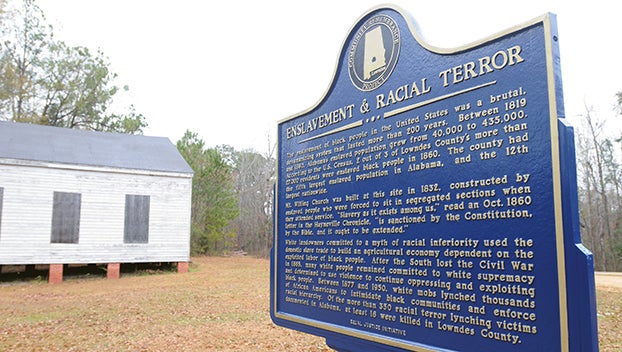History set in stone: Marker dedicated in county
Published 12:30 pm Friday, January 3, 2020

- Historical markers remembering victims of violence in Lowndes County were dedicated recently. | Photo by Mark Rogers
|
Getting your Trinity Audio player ready...
|
A marker unveiling to remember three victims of violence in Lowndes County will be was held recently at a historic church.
The dedication ceremony took place at the historic Hopewell Baptist Church at 126 Snowhill Dr. near Fort Deposit (off AL-21 in the Mt. Willing community).
“The event honored lynching victims G. Smith Watkins, Ed Bracy and Jim Press Meriweather, who were killed in 1935, for starting a Lowndes County Sharecroppers union,” Josephine Bolling McCall of the Elmore Bolling Foundation said. “The Elmore Bolling Foundation has been working with the EJI (Equal Justice Initiative) and the community collation led by the Lowndes County Friends of the Civil Rights Movement to create this dedication.”
The marker presentation comes from the Lowndes County Community Remembrance Coalition, which is led by the Lowndes County Friends of the Civil rights Movement of which Arthur Nelson is president and Katanga Mants is vice president.
The unveiling is part of a larger project to mark other locations in Lowndes County that are historically significant. Soil from sites of lynchings across the county was taken on Nov. 11. The soil will be housed at EJI’s Montgomery museum and portions will be displayed at the sites of the markers.
The marker features two sides with different information on each. On the front, which face AL-21, the marker tells the story of the “Lynching Targeting Black Sharecroppers.”
“In Summer 1935, hundreds of black sharecroppers in Lowndes County, Alabama staged a strike to protest poor pay and mistreatment,” the marker reads. “In response, white mobs and local law enforcement arrested and attacked leaders in a terror campaign, lynching at least three black men within two weeks.”
The marker tells the story of the Aug. 22, 1935 shooting death of Meriweather, a prominent black leader. He was left to die in the woods, and his wife, Annie Mae attacked. She survived.
On Aug. 28, 1935, police arrested Watkins, a black preacher who helped lead the strike. Watkins never made it to the jail and was found shot to death in a swamp near the county line weeks later.
On Sept. 2, 1935, a white mob organized by the Lowndes County sheriff ambushed Bracy at his Hope Hull home, fatally shooting him 19 times in the head and neck.
The back of the marker refers to enslavement and racial terror at the site of a church that was built by enslaved people. It also notes that of the more than 350 racial terror lynching victims in Alabama, at least 16 were killed in Lowndes County.





